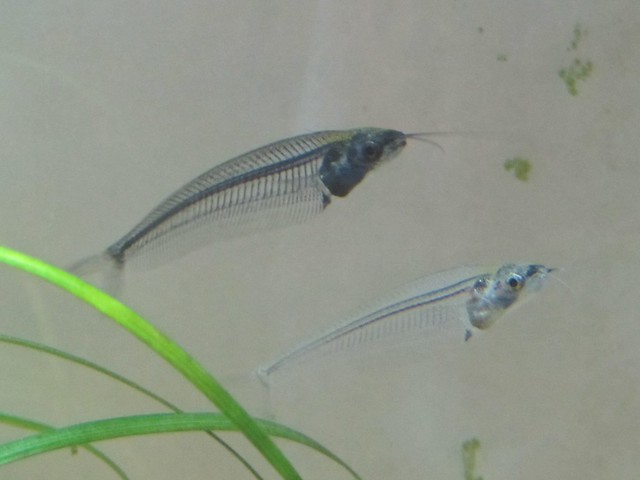The glass catfish or Kryptopterus bicirrhis and its smaller relative the ghost catfish are native to Indonesia. They inhabit the large rivers and turbid waters of Borneo, Sumatra, the Malay Peninsula and the Chao Phrayaa and Mekongg drainage basins. They live near the shorelines in water with strong currents. They are diurnal predators (active in daylight) whose diet consists mainly of true water bugs in the wild.
 |
| Photo by Matt Ryall |
Glass catfish are some of the most unusual fish you can buy for a freshwater aquarium. Their bodies are totally devoid of scales and their skin and meaty tissue is completely transparent. You can see right trough to its bones and internal organs and out the other side of their bodies.
As with all Catfish, they have barbells on either side of their mouths.
Glass catfish have a docile temperament. They make good community fish as long as they are in the company of similarly mild mannered fish. Glass catfish are a medium sized fish. They grow to about four inches in length. They are mid-tank swimmers.
The shoaling instinct runs extremely strong in these creatures. A glass catfish will not survive without another member of its own species in the tank. If you have two and one dies, the other will die shortly thereafter if you do not add another glass catfish to your tank. It is, therefore, advisable to keep at least four of them at a time.
Glass catfish are every bit as fragile as their name. They have been known not to survive the trip home from the fish store. Once home, their chances of survival are significantly increased in a heavily planted aquarium. They are a shy species and will fare much better given plenty of places to hide.
Glass catfish prefer neutral to slightly acidic water (pH 6.8-7.0). They are better suite for a water temperature a little cooler than some other tropical fish. The ideal temperature range is 70-79 degrees Fahrenheit. They function best in subdued lighting. And you want to have a filtering system that provides plenty of water flow to simulate the currents they are accustomed to living in. Under premium condition they have a life expectancy of 6 to 8 years.
Glass catfish are egg layers. Attempts to spawn them in captivity have thus far failed. So the ones you see at the fish store have been recently removed from their native environment. They may very well suffer from escalated stress levels until they adapt to their new surroundings.
Remember, these are not commercially raise fish. In the wild their diet consists primarily of true water bugs. They are carnivores that are accustomed to eating live food. In order to make help them adapt to their new environment you should start out by feeding them brine shrimp. Small insect larvae are preferable if you can find them. They will eventually learn to eat freeze-dried, frozen food and possibly even tropical fish flakes. But you still want to supplement their diet with live protein to insure their continued hardiness. These are, after all, rather delicate creatures.
The mere mention of the word "saltwater" sends shivers up many freshwater aquarium owners' spines. In the past decade a new segment of the aquarium industry has been created for home aquarium owners; the Jellyfish Aquarium Fish Tank. Jellyfish aquariums are much easier to maintain than traditional saltwater tanks. Pet Moon Jellyfish look absolutely incredible under a fading LED lighting system. Article Source: EzineArticles |


